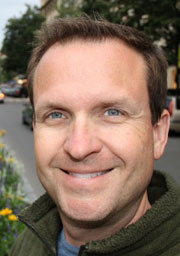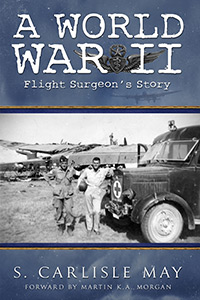World War II Flight Surgeon
Click here to read the first three pages.
Foreword by Martin K.A. Morgan, Author/Historian
Chapter by Chapter Outline
Chapter 1 Preparing for Service
Dr. Myhr’s family background is briefly described with emphasis placed on his medical school experience and his induction into the Army Air Force. His fight surgeon training, and his being stationed throughout the U.S. is detailed along with his eventual travel to the desert of North Africa to join the 314th Troop Carrier Command in the war effort.
Chapter 2 Africa 1943
Dr. Myhr arrives to the dust and heat of Africa. There he cares for pilots, crewmen, enlisted men and civilians, if necessary, under unfamiliar conditions. Most diseases he treats he’s only seen in text books. He becomes health inspector, handles injuries after missions and is confessor for the pilots when they need one. The medical clinic and setup Dr. Myhr worked in, along with what a “typical” day for him might be like are described.
Chapter 3 Medicine
Procedures Dr. Myhr used for handling injured men are detailed along with the types of diseases he treats and the medical supplies he had at his disposal. A description of his job as health inspector and mental health provider for the pilots is provided.
Chapter 4 Sicily
The invasion of Sicily takes place and Dr, Myhr along with the pilots he is responsible for play a major role. The operation for the delivery of paratroopers is described. Dr. Myhr arrives in Sicily only days after the invasion began. He shares his thoughts on the country, the people and the type of work he is doing. Here some of Dr. Myhr’s friends are introduced. His living conditions are described. He is present when Generals Clark, Patton and Eisenhower meet to plan the invasion into Italy and there when President Roosevelt visits.
Chapter 5 Britain – February 1944 to June 1944
Dr. Myhr is transferred to England to prepare for the invasion of Normandy. Living conditions improved greatly and many of the medical issues resulted from having to do with cold damp weather. Pilots are practicing for the invasion of France whenever the sky clears. Dr. Myhr works on the base, in a hospital and in transporting patients by plane.
Chapter 6 Keep Them Flying
Dr. Myhr’s total focus in England turns to keeping pilots healthy enough both mentally and physically to fly. This involves routine medical meetings, screening of men, giving of shots and evaluation of mental issues. He is performing regular health inspections and submitting reports. Injuries still occur but many of these are from bicycle accidents or from and cutting fire wood. Flying fatigue continues to be a major concern to be aware of and address.
Chapter 7 Preparing to Invade
Pilots and crewmen work to exhaustion in an effort to prepare for the invasion. Training goes on day and night as long as the weather permits. The buildup of men and planes is massive, stretching the medical service personnel to the limit. Public health issues became more difficult to handle. The strain the men are under often results in senseless flight accidents. Days before D-Day the camps are put on lock-down and Dr. Myhr watches the men closely to see if they are mentally prepared. Later, he looks into the night sky as the pilots he knows so well fly into danger, not knowing if any will return.
Chapter 8 D-Day
The 314th Troop Carrier Command planes dropped paratroopers from both the 82nd and 101th Airborne Divisions over France. Gliders filled with paratrooper were also towed by the C-47s. Pilot accounts of the invasion are given. When the pilots return Dr. Myhr is there to see about them, and check for any unusual reactions like shaking hands or acting out of character. Accounts of these reactions are detailed. Hours after the planes returned, re-supply missions are flown. Pilots almost flew beyond human endurance and mentally safe.
Chapter 9 France and Belgium – July 1944 to December 1944
Two month after D-Day, Dr. Myhr is transferred to the new Field in France. Here he is responsible for medical care in a rest camp where pilots are sent for R&R. Venereal diseases are a major problem. The 314th TCC participates in operation MARKET-GARDEN. Pilots must fly large, slow planes without being allowed to maneuver out of the range of gunfire. Wet winter weather brings about constant illnesses requiring Dr. Myhr’s care. Evacuation of the wounded by plane becomes the innovative way of saving lives and the 314th TCC participates in this service.
Chapter 10 Belgium and Germany – Early 1945
Dr. Myhr is attached to different units as he works evacuating patients and being the attending doctor in rest camps. The 314th TCC takes part in operation VARSITY. Re-supply and evacuation becomes their main job. The greatest losses in the group accrued during this time—seven planes and all crew members are lost.
Chapter 11 Combat Control Teams
As a senior medical officer, with years of experience, Dr. Myhr is assigned to a Combat Control Team. These teams are organized to support the airborne divisions. As frontline teams, they take airfields so quickly that the food on the German’s plates is still warm. Dr. Myhr’s job is to provide medical care and see that the wounded were evacuated quickly. Details are given in how these specialize teams are structured. Dr. Myhr takes his turn providing medical care for the prisoners of Dachau and Buchenwald concentration camps.
Chapter 12 End of War
Dr. Myhr is stationed in Germany when the war in the European theater ends. He travels by boat to New York and by train to Atlanta, where he is discharged. He returns home to his wife and child. He is already in the States by the time the bomb is dropped on Japan. The 314th Troop Carrier Command is disbanded and absorbed back into the 8th Army Air Force. Dr. Myhr lives to be ninety years old.

